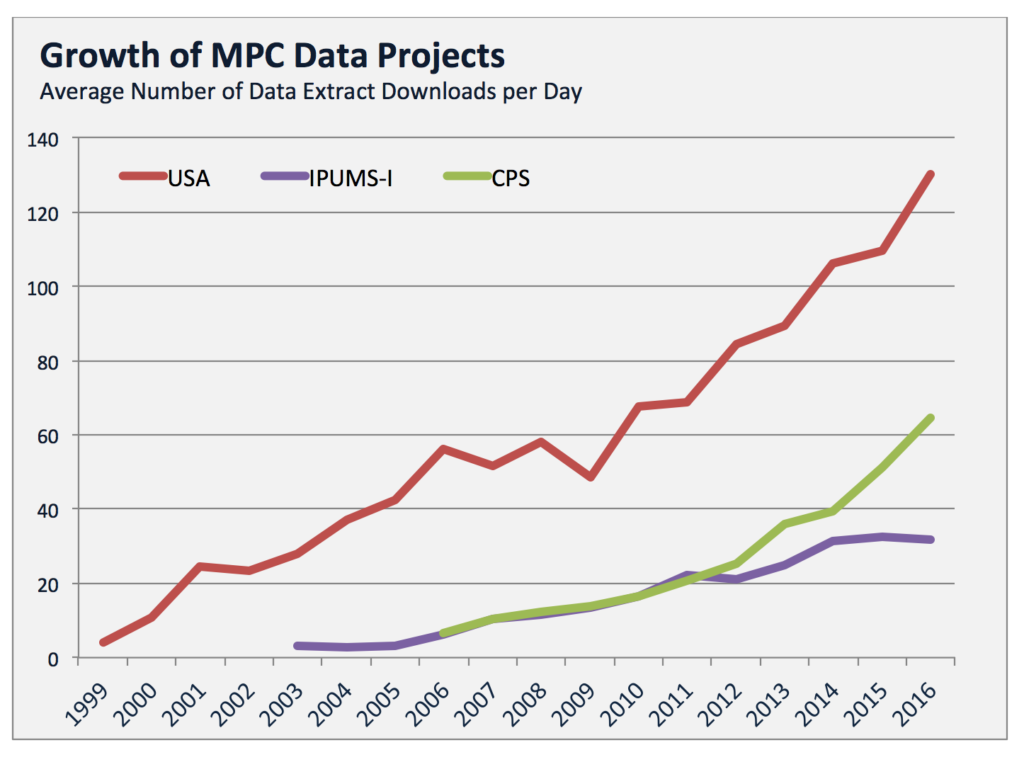
Use of IPUMS data has grown steadily over the past 15 years. In particular, the IPUMS USA and IPUMS CPS projects have recognized a considerable increase in daily downloads since their inception. Despite this growth in use, however, the future of federal statistics data collection is in question as the United States transitions to a new Presidential administration.
IPUMS USA, a project that includes the American Community Survey (ACS), has experienced an increase in downloads from roughly four per day in 1999 to over 130 per day in 2016. Similarly, downloads of IPUMS CPS, a project that includes the Current Population Survey (CPS), have gone from about 6 per day in 2006 to just below 65 a day in 2016. IPUMS International, now the largest publicly available collection of international census data in the world, has also experienced a noticeable increase in use, from about three downloads per day to over 30 per day in the past 10 years.
This growth in the use of IPUMS data, collected by federal statistical agencies like the U.S. Census Bureau and the Bureau of Labor Statistics (BLS), persists despite rising uncertainty about the future of support for such efforts. A news article published in the journal Science highlighted several concerns for the U.S. Census Bureau and one of its flagship products, the ACS. One factor leading to the uncertainty is the President’s nomination to head the Office of Management and Budget, Representative Mick Mulvaney, who, in 2012, voted to defund the ACS. Relatedly, the U.S. Census Bureau has plans to request a $263 million increase to its budget as it prepares for the 2020 census. Talks about across-the-board budget cuts, seemingly jeopardizing the Census Bureau’s constitutional obligation, persist despite the reality that the President, himself, has yet to publicly address his plans for the Census Bureau.
The future is even more unclear for BLS. The CPS is the key tool for calculating labor force and unemployment statistics. Although the BLS reported the official unemployment rate for December 2016 to be at 4.7%, during his campaign the President suggested that the “real” unemployment rate may be 42%. This discrepancy has left many wondering if the White House and the BLS are on an irreconcilable collision course.
Brent Moulton, a veteran of the federal statistical system who worked at the BLS and the Bureau of Economic Analysis, recently speculated about the uncertain future and the legacy of political independence of the BLS in a post on his blog. Moulton acknowledges that the BLS actually releases several alternative calculations of the unemployment rate, with the broadest calculation resting at 9.2% for December. Still, for the rate to be as high as 42% the BLS would need to include millions of people who have never been included in the calculation in the past, including retirees, students, stay-at-home parents, and the disabled.
It is possible that the President will quietly let the disparities he campaigned on fade away as campaign rhetoric. In this scenario the President recognizes that the BLS works for him and there is little political gain in fighting national survey data that could actually be of benefit for his administration’s leadership of the United States government. A second possibility is that the White House forces the BLS to begin reporting and emphasizing alternative and broader calculations of the unemployment rate. While shifts in methodology mandated by the White House may sound bad on the surface, Moulton points out that this may come with some benefit as both the President and many economists have argued that traditional unemployment statistics leave out many who perhaps should be counted. A third possibility is that the battle between the BLS and the White House continues to snowball. In this scenario many of the best employees who work in federal statistics collection are ultimately driven away and statisticians and economists are discouraged from serving the federal government in the future.
Yet despite all of this uncertainty and wide-ranging possibilities for the future, the figure above of daily data extracts downloaded shows that the public is increasingly relying on data and statistics collected by the federal government. Public use data is a valuable resource for achieving many commonly shared goals. IPUMS data users come from a diverse background; they include local entrepreneurs and business consultant agencies, journalists and public policy wonks, in addition to researchers from universities and think tanks. Given the importance of federal statistics data for policy making, scientific research, education, and accurate reporting on important social, economic, and health trends, it would benefit all data users to connect with their elected leaders to urge them to support funding for the Census Bureau and the BLS.
Story by Jeff Bloem
